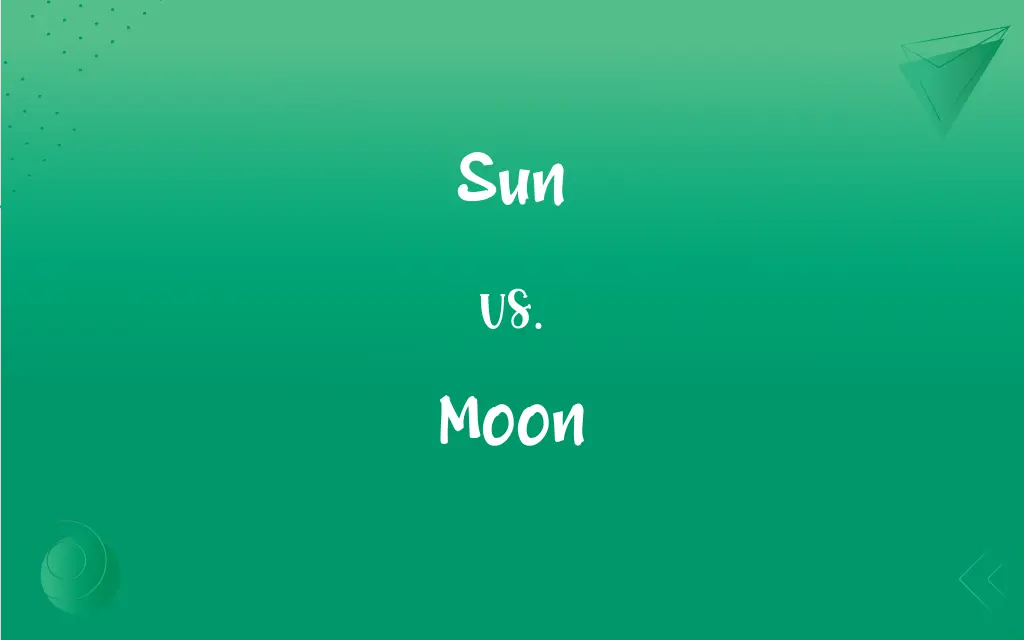Sun vs. Moon: What's the Difference?
By Janet White || Published on December 2, 2023
The Sun is a star at the center of our solar system providing light and heat, while the Moon is Earth's natural satellite reflecting the Sun's light.

Key Differences
The Sun is a massive, luminous sphere of plasma, a star that is the primary source of light and heat for the planets in the solar system. In contrast, the Moon is a solid, rocky body orbiting Earth, illuminated by the Sun's light.
The Sun’s surface, known as the photosphere, is where light is emitted, making it visible from Earth. However, the Moon's surface, covered in craters, mountains, and lava plains, reflects the sunlight, making it visible in our night sky.
The Sun is essential for Earth’s climate and weather, influencing life through its energy. Whereas, the Moon affects Earth by causing tides, stabilizing the planet's rotation, and influencing various biological rhythms.
In terms of size and composition, the Sun, composed primarily of hydrogen and helium, dwarfs the Moon, which is made up of silicate rock. The Sun's immense gravity holds the solar system together, while the Moon's weaker gravity affects Earth's tides.
Culturally, the Sun has been worshipped in many societies as a life-giving deity, symbolizing power and energy. The Moon has often been associated with mystery and romance, influencing various aspects of culture, including calendar systems and mythology.
ADVERTISEMENT
Comparison Chart
Nature
Star
Natural Satellite
Composition
Hydrogen, Helium
Silicate rock
Role in Solar System
Central, gravitational anchor
Earth's satellite
Effect on Earth
Source of light and heat
Causes tides, stabilizes rotation
Cultural Significance
Symbol of power, life
Associated with mystery, romance
ADVERTISEMENT
Sun and Moon Definitions
Sun
A symbol of energy and power.
In many cultures, the Sun is worshipped as a deity.
Moon
An influencer of Earth's tides.
The gravitational pull of the Moon causes the ocean's tides.
Sun
The star at the center of our solar system.
The Sun provides the necessary light and heat to sustain life on Earth.
Moon
Earth's natural satellite.
The Moon orbits the Earth approximately every 27 days.
Sun
A source of light and heat.
Plants rely on sunlight to perform photosynthesis.
Moon
A celestial body reflecting sunlight.
The Moon shines at night by reflecting the Sun's light.
Sun
The most important source of energy for Earth.
Solar panels harness the Sun's energy to produce electricity.
Moon
A symbol of mystery and romance.
Many poets have drawn inspiration from the beauty of the Moon.
Sun
The gravitational center of the solar system.
The Sun's gravity keeps the planets in their orbits.
Moon
A key factor in Earth's ecological balance.
The Moon's gravitational pull contributes to the stability of Earth's climate.
Sun
A star that is the center of a planetary system.
Moon
Often Moon The natural satellite of Earth, visible by reflection of sunlight and having a slightly elliptical orbit, approximately 363,100 kilometers (225,600 miles) distant at perigee and 405,700 kilometers (252,100 miles) at apogee. Its mean diameter is 3,475 kilometers (2,159 miles), its mass approximately one eightieth that of Earth, and its average period of revolution around Earth 29 days 12 hours 44 minutes calculated with respect to the sun.
FAQs
Is the Sun bigger than the Moon?
Yes, the Sun is significantly larger than the Moon.
How does the Moon affect Earth?
The Moon affects Earth by causing tides and stabilizing its rotation.
Does the Moon emit its own light?
No, the Moon reflects the light of the Sun.
What is the Sun made of?
The Sun is primarily composed of hydrogen and helium.
How far is the Moon from Earth?
The Moon is about 238,855 miles (384,400 kilometers) away from Earth.
Can we live on the Sun or Moon?
No, humans cannot live on the Sun due to its extreme heat, nor on the Moon due to its lack of atmosphere and essential resources.
Does the Moon have gravity?
Yes, the Moon has its own gravity, though weaker than Earth's.
Is the Sun a planet?
No, the Sun is a star.
Can we see the Moon during the day?
Yes, the Moon can sometimes be visible during the day.
Why does the Moon have phases?
The Moon has phases due to its orbit around Earth and the changing angles of sunlight it reflects.
What causes lunar eclipses?
Lunar eclipses occur when the Earth comes between the Sun and the Moon, and the Moon passes into Earth's shadow.
Does the Sun move?
The Sun moves within the Milky Way galaxy, but it appears stationary from Earth's perspective.
What causes solar eclipses?
Solar eclipses occur when the Moon passes between Earth and the Sun, casting a shadow on Earth.
Why is the Sun important for life on Earth?
The Sun is crucial for life due to its light and heat, driving climate and weather, and supporting photosynthesis.
Is the Sun the only star in our solar system?
Yes, the Sun is the only star in our solar system.
Can we see the dark side of the Moon?
No, the same side of the Moon always faces Earth due to its synchronous rotation.
What is a Blue Moon?
A Blue Moon is a term used for the second full moon in a calendar month.
How old is the Sun?
The Sun is about 4.6 billion years old.
Do other planets have moons?
Yes, other planets in our solar system also have moons.
Can the Moon affect human behavior?
There is no scientific evidence to support the Moon having a direct effect on human behavior.
About Author
Written by
Janet WhiteJanet White has been an esteemed writer and blogger for Difference Wiki. Holding a Master's degree in Science and Medical Journalism from the prestigious Boston University, she has consistently demonstrated her expertise and passion for her field. When she's not immersed in her work, Janet relishes her time exercising, delving into a good book, and cherishing moments with friends and family.






































































